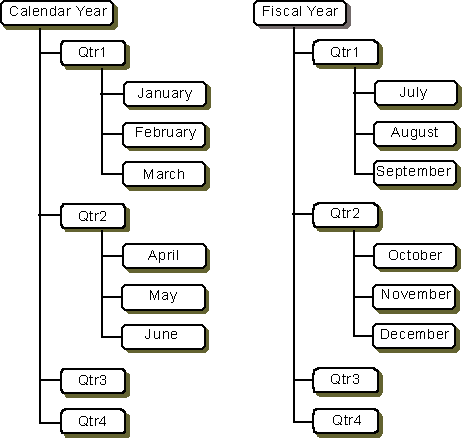Supported Hierarchy Types
| OLE DB Programmer's Reference |
OLE DB for OLAP supports four hierarchy types: balanced, ragged, unbalanced, and network.
One of the most common types is the balanced hierarchy. In a balanced hierarchy, the parent of each member comes from the level immediately above the member. Most hierarchies on the Time dimension are balanced.

In a ragged hierarchy, the parent of a member can come from any level above the level of the member, not just from the level immediately above. This type of hierarchy can also be referred to as ragged-balanced, because levels still exist. A Geography dimension is a typical example of such a hierarchy.

In this example, there is still the concept of a named level—and Country applies equally well to both branches of the hierarchy. The Continent level also applies, but only on one branch of the hierarchy.
In an unbalanced hierarchy, the concept of levels does not apply. Consider a dimension containing components for various products. Because different products contain totally different parts, no notion of a level exists.
The distinguishing feature of a network hierarchy is that nodes can contain more than one parent. A family tree is a common example.
OLE DB for OLAP supports all four types of hierarchies. The MEMBERS schema rowset has not only a parent name but also the level number of the parent. Similarly, the restrictions on this rowset enable you to browse not only by moving up and down the levels but also by moving up and down the inheritance tree.
1998-2001 Microsoft Corporation. All rights reserved.
EAN: 2147483647
Pages: 1083
- Structures, Processes and Relational Mechanisms for IT Governance
- A View on Knowledge Management: Utilizing a Balanced Scorecard Methodology for Analyzing Knowledge Metrics
- Measuring ROI in E-Commerce Applications: Analysis to Action
- Governing Information Technology Through COBIT
- The Evolution of IT Governance at NB Power